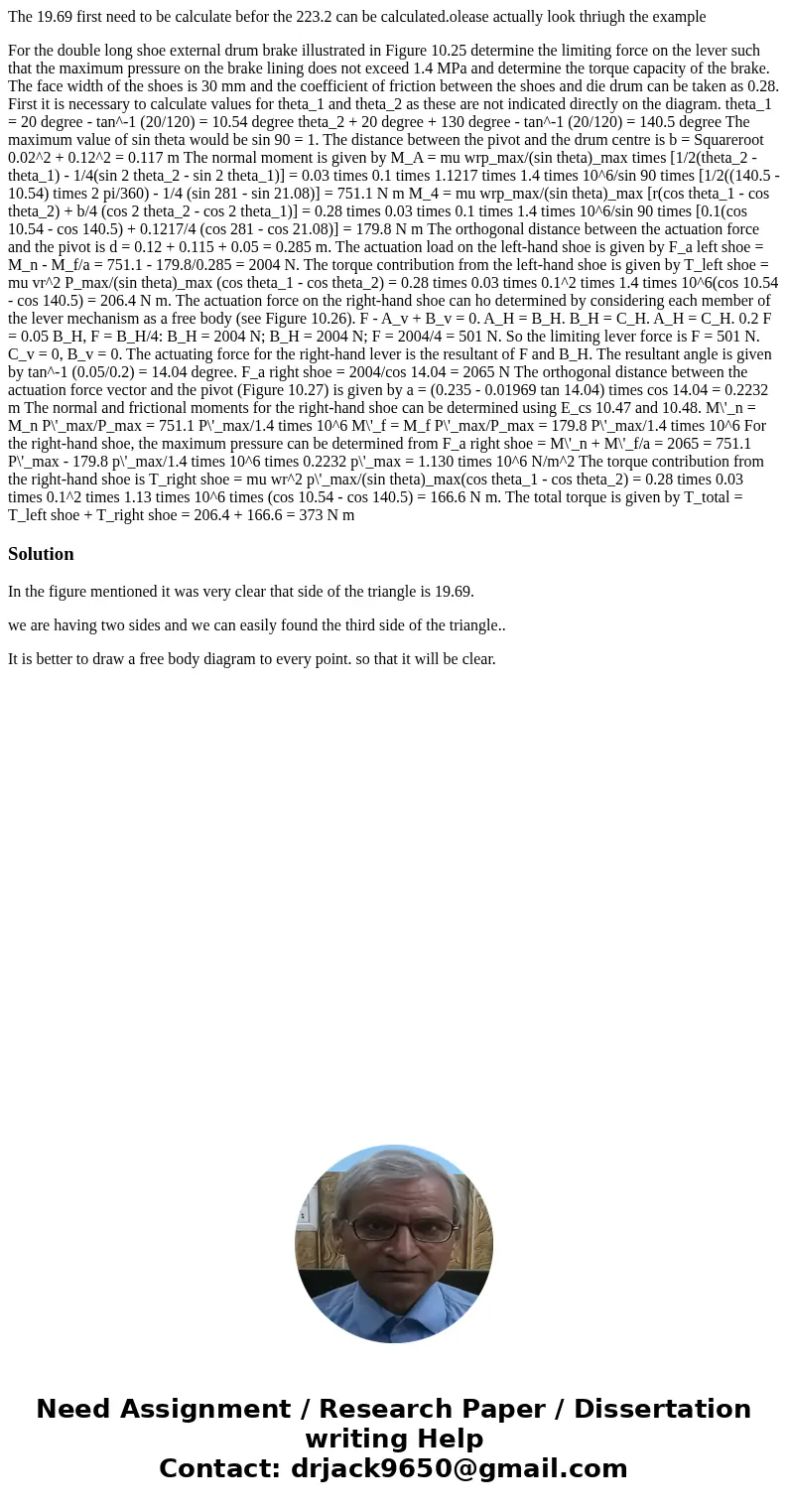The 1969 first need to be calculate befor the 2232 can be ca
The 19.69 first need to be calculate befor the 223.2 can be calculated.olease actually look thriugh the example
For the double long shoe external drum brake illustrated in Figure 10.25 determine the limiting force on the lever such that the maximum pressure on the brake lining does not exceed 1.4 MPa and determine the torque capacity of the brake. The face width of the shoes is 30 mm and the coefficient of friction between the shoes and die drum can be taken as 0.28. First it is necessary to calculate values for theta_1 and theta_2 as these are not indicated directly on the diagram. theta_1 = 20 degree - tan^-1 (20/120) = 10.54 degree theta_2 + 20 degree + 130 degree - tan^-1 (20/120) = 140.5 degree The maximum value of sin theta would be sin 90 = 1. The distance between the pivot and the drum centre is b = Squareroot 0.02^2 + 0.12^2 = 0.117 m The normal moment is given by M_A = mu wrp_max/(sin theta)_max times [1/2(theta_2 - theta_1) - 1/4(sin 2 theta_2 - sin 2 theta_1)] = 0.03 times 0.1 times 1.1217 times 1.4 times 10^6/sin 90 times [1/2((140.5 - 10.54) times 2 pi/360) - 1/4 (sin 281 - sin 21.08)] = 751.1 N m M_4 = mu wrp_max/(sin theta)_max [r(cos theta_1 - cos theta_2) + b/4 (cos 2 theta_2 - cos 2 theta_1)] = 0.28 times 0.03 times 0.1 times 1.4 times 10^6/sin 90 times [0.1(cos 10.54 - cos 140.5) + 0.1217/4 (cos 281 - cos 21.08)] = 179.8 N m The orthogonal distance between the actuation force and the pivot is d = 0.12 + 0.115 + 0.05 = 0.285 m. The actuation load on the left-hand shoe is given by F_a left shoe = M_n - M_f/a = 751.1 - 179.8/0.285 = 2004 N. The torque contribution from the left-hand shoe is given by T_left shoe = mu vr^2 P_max/(sin theta)_max (cos theta_1 - cos theta_2) = 0.28 times 0.03 times 0.1^2 times 1.4 times 10^6(cos 10.54 - cos 140.5) = 206.4 N m. The actuation force on the right-hand shoe can ho determined by considering each member of the lever mechanism as a free body (see Figure 10.26). F - A_v + B_v = 0. A_H = B_H. B_H = C_H. A_H = C_H. 0.2 F = 0.05 B_H, F = B_H/4: B_H = 2004 N; B_H = 2004 N; F = 2004/4 = 501 N. So the limiting lever force is F = 501 N. C_v = 0, B_v = 0. The actuating force for the right-hand lever is the resultant of F and B_H. The resultant angle is given by tan^-1 (0.05/0.2) = 14.04 degree. F_a right shoe = 2004/cos 14.04 = 2065 N The orthogonal distance between the actuation force vector and the pivot (Figure 10.27) is given by a = (0.235 - 0.01969 tan 14.04) times cos 14.04 = 0.2232 m The normal and frictional moments for the right-hand shoe can be determined using E_cs 10.47 and 10.48. M\'_n = M_n P\'_max/P_max = 751.1 P\'_max/1.4 times 10^6 M\'_f = M_f P\'_max/P_max = 179.8 P\'_max/1.4 times 10^6 For the right-hand shoe, the maximum pressure can be determined from F_a right shoe = M\'_n + M\'_f/a = 2065 = 751.1 P\'_max - 179.8 p\'_max/1.4 times 10^6 times 0.2232 p\'_max = 1.130 times 10^6 N/m^2 The torque contribution from the right-hand shoe is T_right shoe = mu wr^2 p\'_max/(sin theta)_max(cos theta_1 - cos theta_2) = 0.28 times 0.03 times 0.1^2 times 1.13 times 10^6 times (cos 10.54 - cos 140.5) = 166.6 N m. The total torque is given by T_total = T_left shoe + T_right shoe = 206.4 + 166.6 = 373 N mSolution
In the figure mentioned it was very clear that side of the triangle is 19.69.
we are having two sides and we can easily found the third side of the triangle..
It is better to draw a free body diagram to every point. so that it will be clear.

 Homework Sourse
Homework Sourse